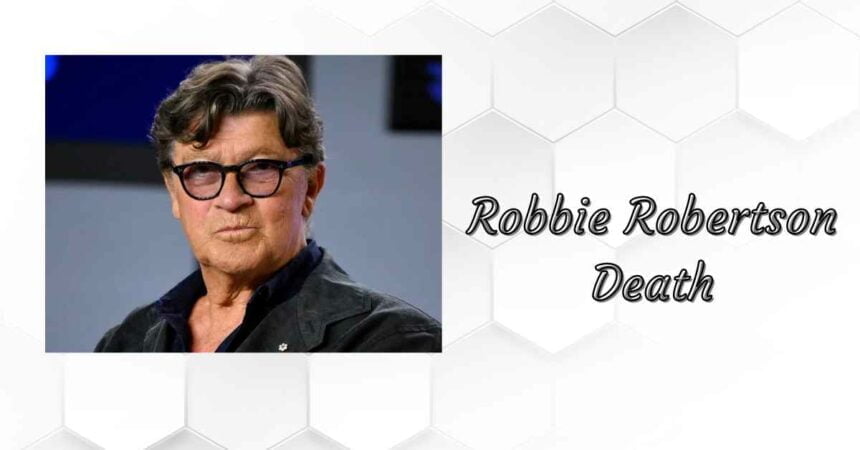Robbie Robertson, guitarist, songwriter, and vocalist who helped bring the Band to rock stardom in the 1970s and collaborated extensively with Bob Dylan and Martin Scorsese, has passed away. He was 80.
Robbie Robertson Death
Robertson passed away on Wednesday in Los Angeles after a lengthy illness, according to a statement released by his management.
In a statement, Robertson’s manager of 34 years, Jared Levine, said, “Robbie was surrounded by his family at the time of his death, including his wife, Janet, his ex-wife, Dominique, her partner Nicholas, and his children Alexandra, Sebastian, Delphine, and Delphine’s partner Kenny.”
His grandkids, Angelica, Donovan, Dominic, Gabriel, and Seraphina, will continue his legacy. This is Robertson and Scorsese’s thirteenth picture together, and they’ve worked together for a long time on ‘Killers of the Flower Moon.’ A new Woodland Cultural Center for the Six Nations of the Grand River has been established as the family’s preferred memorial instead of flowers.
Rest in peace Robbie Robertson, legendary lead guitarist of The Band, fellow Canadian, and cherished collaborator of Joni’s. May his legacy and musical harmony resonate for generations to come.
Photo from the Michael Ochs Archives pic.twitter.com/1rdu7tihjS
— Joni Mitchell (@jonimitchell) August 9, 2023
Robbie Robertson’s Early Years
half Mohawk, half Cayuga (a Native American tribe from New York state), and part Jewish. Jaime Royal Robertson was born on July 5, 1943, in Toronto. His biological father and he never got to meet. In the summers, he would visit the reserve where his mother grew up among the Six Nations of the Grand River.
Robertson’s band opened for Hawkins in a Toronto bar when he was 15. Robertson heard Hawkins tell his band he needed new songs, so he penned “Someone Like You” and “Hey Boba Lu” that night and presented them to Hawkins the following day; Hawkins recorded both. Levon Helm was already a member of Hawkins’ band when Robbie Robertson joined shortly after.
The Band and its Legacy: With and After Bob Dylan
Following their break with Hawkins, Robertson and the others decided to back Bob Dylan on his 1965 U.S. tour and 1966 world tour, the latter of which featured a May 1966 performance in England during which an audience member yelled “Judas!” in protest of Dylan’s adoption of electronic music.
After his tragic motorcycle accident later that year, Dylan found solace in the Woodstock region, where The Band soon made their home. Songs like “Tears of Rage” and “I Shall Be Released” from the upcoming album “The Basement Tapes” were written and recorded during this time. First published in 1975, a complete six-disc set was made available in 2014.
If you click on the link below, you may read about similar topics:
- Josh Seiter Bachelorette Season: What Was His Cause Of Death?
- Luke Harper Cause Of Death: WWE Wrestler who Tragically Died At 41!!
Dylan pushed for The Band to record their album, and the results are timeless: “Music from Big Pink” and “The Band,” both from the late ’60s. In “Music from Big Pink,” Robertson’s “The Weight” was included. Robertson contributed six songs to the follow-up album “The Band,” released in 1969. These songs included “The Night They Drove Old Dixie Down” and “Up On Cripple Creek.”
Robertson recalls giving Dylan a listen to “Music from Big Pink” in his biography “Testimony,” published in 2016. Bob gave ‘his’ band a pleased look after every performance. He said, “This is fantastic,” as “The Weight” began playing. Who composed the tune? Me, I retorted. He hit me on the arm, shook his head, and said, “Damn!” Did you write the tune?
Robertson and the Band: From Woodstock to ‘The Last Waltz’
The Band’s performance at the Woodstock festival in 1969, not far from where they resided, made them famous enough to get on the cover of Time. Robertson planned a farewell concert for The Band, which they performed after over a decade together, entitled The Last Waltz.
Dylan, Van Morrison, Neil Young, Muddy Waters, and many more gathered in San Francisco’s Winterland Ballroom to be shot by Martin Scorsese for his documentary “The Last Waltz,” which premiered in 1978.
Garth and I trying to recruit a new member of The Band. #InternationalCatDay pic.twitter.com/v4DZ9UwyBW
#InternationalCatDay pic.twitter.com/v4DZ9UwyBW
— Robbie Robertson (@r0bbier0berts0n) August 8, 2023
In the wake of “The Last Waltz,” ties between Robertson and Helm began to fray. Helm accused Robertson of avarice and inflated ego in his 1993 biography “Wheel on Fire,” he also noted that Robertson had acquired ownership of the band’s collection of songs. Robertson said that he became the group’s leader because everyone else, except Hudson, was too impaired by their substance abuse to make judgments.
It was Scorsese’s films—”The Color of Money,” “The King of Comedy,” “The Departed,” and “The Irishman”—that launched Robertson’s illustrious career as a composer. The Band’s history will be the subject of a documentary titled “Once Were Brothers,” which Scorsese will executive produce in 2020.
Neil Diamond’s “Beautiful Noise,” from 1976, was produced by Robertson, who also had a successful solo career. His debut solo album, 1987’s “Robbie Robertson,” had guests including Bono, Peter Gabriel, Maria McKee, Garth Hudson, and Rick Danko from The Band, and went gold. Albums like “Contact from the Underworld of Redboy” and “Music for the Native Americans” delved further into his background.
Artists as diverse as Aretha Franklin, Joan Baez, and the Staple Singers have recorded songs by The Band, who were elected into the Rock and Roll Hall of Fame in 1994, and their impact can be felt throughout many generations.
In an interview with Dan Rather in 2020, Robertson said that the band “put it all in this big pot, stirred it up, and when we put it out, people were like, what’s that?” And I explained what it is: individuals have gathered in the woods and practiced their craft for years for music. To pursue a career in pop music is unrelated to this. All the band members had a similar appreciation for the nuances of music. That’s why we were able to work together to accomplish it.”



